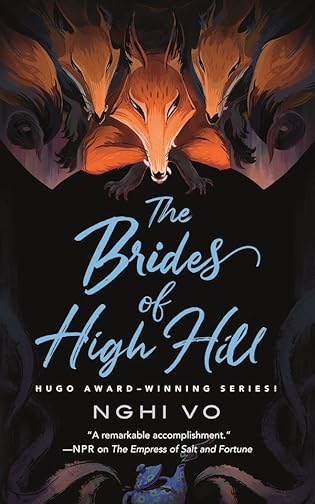 The Brides of High Hill (The Singing Hills Cycle, #5) by Nghi Vo
The Brides of High Hill (The Singing Hills Cycle, #5) by Nghi Vo Format: eARC
Source: supplied by publisher via Edelweiss
Formats available: hardcover, ebook, audiobook
Genres: fantasy
Series: Singing Hills Cycle #5
Pages: 128
Published by Tordotcom on May 7, 2024
Purchasing Info: Author's Website, Publisher's Website, Amazon, Barnes & Noble, Kobo, Bookshop.org, Better World Books
Goodreads
The Hugo Award-Winning Series returns with its newest standalone entry: a gothic mystery involving a crumbling estate, a mysterious bride, and an extremely murderous teapot.
The Cleric Chih accompanies a beautiful young bride to her wedding to an aging lord at a crumbling estate situated at the crossroads of dead empires. But they’re forgetting things they ought to remember, and the lord’s mad young son wanders the grounds at night like a hanged ghost.
The Singing Hills Cycle has been shortlisted for the Lambda Literary Award, the Locus Award, the Ignyte Award, and has won the Hugo Award and the Crawford Award.
My Review:
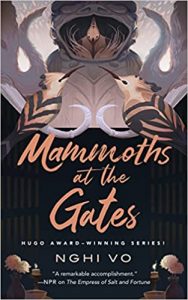 When we first catch up with Cleric Chih as they are accompanying bride-to-be Pham Nhung and her family on their trip to make the final negotiations for Pham Nhung’s marriage to the older and much wealthier Lord Guo, the reader has the sense that they remember when Chih met Nhung at the gates of the Singing Hills Abbey back in the previous book, Mammoths at the Gates.
When we first catch up with Cleric Chih as they are accompanying bride-to-be Pham Nhung and her family on their trip to make the final negotiations for Pham Nhung’s marriage to the older and much wealthier Lord Guo, the reader has the sense that they remember when Chih met Nhung at the gates of the Singing Hills Abbey back in the previous book, Mammoths at the Gates.
Just as Chih has been lulled into participating in this journey that seems so familiar, so are we.
Because the journey IS familiar, even if Chih can’t seem to recall precisely how they got there or, more importantly, why his friend and companion, the neixin Almost Brilliant, is not with them on this journey. Although, considering the events of Mammoths at the Gates, it’s not too difficult for the reader, or Chih, to understand why the situation back home might have been a bit too fraught for Almost Brilliant to leave.
But the story does seem familiar, only because it is. A young woman whose noble family is a bit down on their luck has been sold to a wealthy older man in order to restore the family’s status. She has no choice in the matter, her parents have little, and Lord Guo has it all.
However, when the Lord’s oldest son, mad and confused and drugged to his eyeballs, under heavy guard and seemingly out of his mind, interrupts the initial ceremonies it raises more than a few uncomfortable questions, which kickstarts Cleric Chih’s need to learn all the stories about the lavish old estate that Lord Guo reigns over with an iron hand – and the familiar story begins to unravel.
Spectacularly. Explosively. Into a story about revenge served, not ice cold, but in a gout of hot blood spraying out from under gnashing teeth and long, sharp claws.
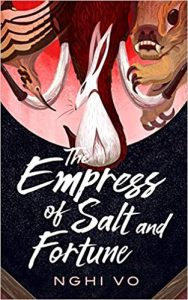 Escape Rating A-: From the very first book in the Singing Hills Cycle, the marvelous The Empress of Salt and Fortune, Cleric Chih has moved from being outside the story, merely its chronicler, to being at the story’s center in Mammoths at the Gates.
Escape Rating A-: From the very first book in the Singing Hills Cycle, the marvelous The Empress of Salt and Fortune, Cleric Chih has moved from being outside the story, merely its chronicler, to being at the story’s center in Mammoths at the Gates.
This time around, Chih is as mesmerized as the reader by the story, as they are trapped within its web just as we ourselves are.
Which means that we have a sense at the beginning that Chih isn’t acting quite like themselves, and Chih has the same feeling. Also they desperately miss their friend Almost Brilliant, and so do we. We all collectively need the clear-sighted neixin to help us – and I’m including Chih in that ‘us’ – figure out what’s going on.
Of course, that’s why Almost Brilliant isn’t there. Or so it seems. Just as so many things in this story seem to be one thing but aren’t – quite.
So this is a story about illusions and lies. Nothing and no one is exactly who or what they are first presented to be. At first, it seems that what began as that rather traditional story of a girl being sold by her parents to a cruel older man is the story and we’re prepared to watch it be broken in some almost traditional way – either by Pham Nhung running away with Lord Guo’s son, who we know isn’t the madman his father’s frightened household says that he is – or with her death, whether by her own hand or Lord Guo’s.
In other words, we expect the illusion to break, but what we don’t expect, what Cleric Chih doesn’t expect, is the way that it breaks – and how thoroughly.
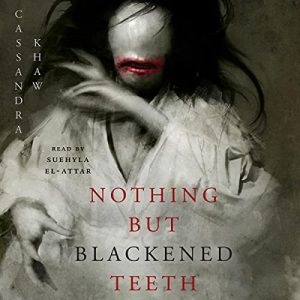 At the very beginning of The Brides of High Hill, Cleric Chih is remembering his late mentor, Cleric Thien, and an occasion where Thien told Chih that “Everything starts with a story,” and a very young and not yet cleric Chih asks, “But what does that mean?”
At the very beginning of The Brides of High Hill, Cleric Chih is remembering his late mentor, Cleric Thien, and an occasion where Thien told Chih that “Everything starts with a story,” and a very young and not yet cleric Chih asks, “But what does that mean?”
In the case of The Brides of High Hill, the story starts with a journey that looks like it might end in a romance but instead ends with something that looks like a bloody, twisted version of Cassandra Khaw’s Nothing But Blackened Teeth, and is all the more surprising for that twist in its – and our – tails at the end.
Leaving this reader with bated breath waiting for the next story in the Singing Hills Cycle, even though it has neither a title nor a projected date of publication, because this series is just that good – and I’m just that hooked on it.

 Into the Riverlands (The Singing Hills Cycle, #3) by
Into the Riverlands (The Singing Hills Cycle, #3) by 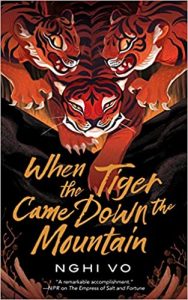 Escape Rating A+: At first, Into the Riverlands seems as if it’s a play on the Canterbury Tales, with Cleric Chih taking the place of Geoffrey Chaucer himself (who, come to think of it, by certain definitions was himself a ‘cleric’). Into the Riverlands is a journey, and every person in the party has at least one story to tell. It’s Chih’s duty to record those stories – not to become a part of one themselves.
Escape Rating A+: At first, Into the Riverlands seems as if it’s a play on the Canterbury Tales, with Cleric Chih taking the place of Geoffrey Chaucer himself (who, come to think of it, by certain definitions was himself a ‘cleric’). Into the Riverlands is a journey, and every person in the party has at least one story to tell. It’s Chih’s duty to record those stories – not to become a part of one themselves.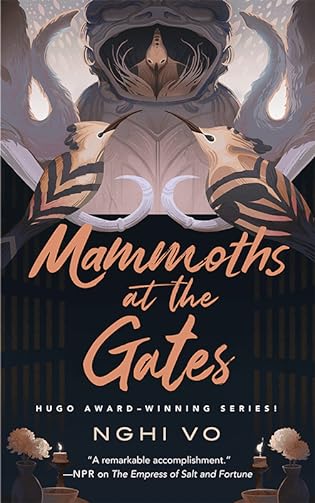 Mammoths at the Gates (The Singing Hills Cycle, #4) by
Mammoths at the Gates (The Singing Hills Cycle, #4) by  It’s also a heartbreakingly beautiful tale of a truth that sets no one free, and a love that both transcends and transforms death.
It’s also a heartbreakingly beautiful tale of a truth that sets no one free, and a love that both transcends and transforms death.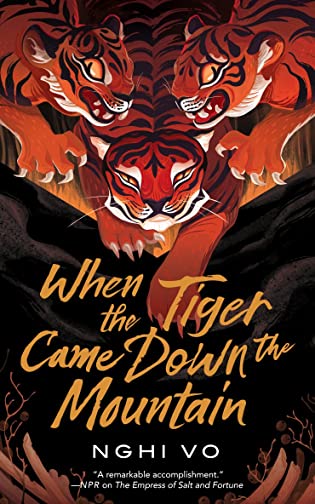 When the Tiger Came Down the Mountain (The Singing Hills Cycle, #2) by
When the Tiger Came Down the Mountain (The Singing Hills Cycle, #2) by 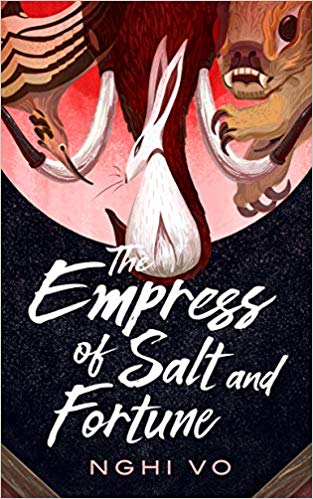 The Empress of Salt and Fortune (Singing Hills Cycle #1) by
The Empress of Salt and Fortune (Singing Hills Cycle #1) by